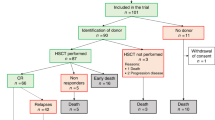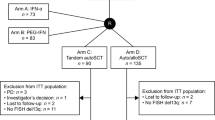Abstract
The place of allogeneic SCT in the management of multiple myeloma remains controversial. Although it may induce long-term clinical and molecular remissions, the very high transplant-related toxicity after a myeloablative preparative regimen has limited its role to younger patients as first-line treatment option. Even with this limited indication, toxic death rate related to infections and GVHD is considered too high and this strategy has been almost abandoned. Reduced intensity conditioning (RIC) regimens look promising, as the transplant-related mortality is low even with matched unrelated donors and can be considered for older patients up to the age of 65 years. However when used in patients with a high tumor burden or with chemo-resistant disease, the immunologic effect of the graft is not sufficient to avoid relapses. Therefore, RIC allotransplantation is currently used after tumor mass reduction with high-dose therapy followed by autologous SCT. A recently published Italian study shows that this strategy induces better event-free survival than double autologous SCT due to a reduced relapse rate. The questions raised by this encouraging result are discussed in this paper.
This is a preview of subscription content, access via your institution
Access options
Subscribe to this journal
Receive 12 print issues and online access
$259.00 per year
only $21.58 per issue
Buy this article
- Purchase on Springer Link
- Instant access to full article PDF
Prices may be subject to local taxes which are calculated during checkout
Similar content being viewed by others
References
Corradini P, Voena C, Tarella C, Astolfi M, Ladetto M, Palumbo A et al. Molecular and clinical remissions in multiple myeloma: role of autologous and allogeneic transplantation of hematopoietic cells. J Clin Oncol 1999; 17: 208–215.
Gahrton G, Tura S, Ljungman P, Blade J, Brandt L, Cavo M et al. Prognostic factors in allogeneic bone marrow transplantation for multiple myeloma. J Clin Oncol 1995; 13: 1312–1322.
Bensinger WI, Buckner CD, Anasetti C, Clift R, Storb R, Barnett T et al. Allogeneic marrow transplantation for multiple myeloma: an analysis of risk factors on outcome. Blood 1996; 88: 2787–2793.
Mehta J . Allogeneic hematopoietic stem cell transplantation in myeloma. In: Mehta J, Singhal S (eds). Myeloma Editions. Martin Dunitz: London, 2002; pp 349–365.
Bjorkstrand BB, Ljungman P, Svensson H, Hermans J, Alegre A, Apperley J et al. Allogeneic bone marrow transplantation versus autologous stem cell transplantation in multiple myeloma: a retrospective case-matched study from the European Group for Blood and Marrow Transplantation. Blood 1996; 88: 4711–4718.
Couban S, Stewart AK, Loach D, Panzarella T, Meharchand J . Autologous and allogeneic transplantation for multiple myeloma. Bone Marrow Transplant 1997; 19: 783–789.
Gahrton G, Svensson H, Cavo M, Apperly J, Bacigalupo A, Björkstrand B et al. Progress in allogeneic bone marrow and peripheral blood stem cell transplantation for multiple myeloma: a comparison between transplants performed 1983–1993 and 1994–1998 at European Group for Blood and Marrow Transplantation centres. Br J Haematol 2001; 113: 209–216.
Barlogie B, Kyle RA, Anderson KC, Greipp PR, Lazarus HM, Hurd DD et al. Standard chemotherapy compared with high-dose chemoradiotherapy for multiple myeloma: final results of the Phase III US Intergroup trial S4321. J Clin Oncol 2006; 24: 929–936.
Alyea E, Weller E, Schlossman R, Canning C, Webb I, Doss D et al. T-cell depleted allogeneic bone marrow transplantation followed by donor lymphocyte infusion in patients with multiple myeloma: induction of graft-versus-myeloma effect. Blood 2001; 98: 934–939.
Lokhorst HM, Segeren CM, Verdonck LF, van der Holt B, Raymakers R, van Oers MH et al. Partially T-cell depleted allogeneic stem-cell transplantation for first-line treatment of multiple myeloma: a prospective evaluation of patients treated in the phase III study Hovon 24 MM. J Clin Oncol 2003; 21: 1728–1733.
Mehta J, Tricot G, Jagannath S, Ayers D, Singhal S, Siegel D et al. Salvage autologous or allogeneic transplantation for multiple myeloma refractory or relapsing after a first autograft. Bone Marrow Transplant 1998; 21: 887–892.
Libura J, Hoffman T, Passweg J, Gregor M, Favre G, Tichelli A et al. Graft-versus myeloma after withdrawal of immunosuppression following allogeneic peripheral stem cell transplantation. Bone Marrow Transplant 1999; 24: 925–927.
Le Blanc R, Montming-Metivier S, Belanger R, Busque L, Fish D, Roy DC et al. Allogeneic transplantation for multiple myeloma: further evidence for a GVHD-associated graft-versus-myeloma effect. Bone Marrow Transplant 2001; 28: 841–848.
Tricot G, Vesole DH, Jagannath S, Hilton J, Munshi N, Barlogie B . Graft-versus myeloma effect: proof of principle. Blood 1996; 87: 1196–1198.
Verdonck L, Lokhorst H, Dekker A, Nieuwenhuis HK, Petersen EJ . Graft versus myeloma effect in two cases. Lancet 1996; 347: 800–801.
Aschan J, Lonnquist B, Ringden O, Kumlien G, Gahrton G . Graft-versus myeloma effect. Lancet 1996; 348: 346.
Collins RH, Shpilberg O, Drobyski Wr, Porter DL, Giralt S, Champlin R et al. Donor lymphocyte infusions in 140 patients with relapsed malignancies after allogeneic bone marrow transplantation. J Clin Oncol 1997; 22: 835–843.
Lokhorst HM, Wu K, Verdonck LF, Laterveer LL, van de Donk NW, van Oers MH et al. The occurrence of graft versus host disease is the major predictive factor for response to donor lymphocyte infusions in multiple myeloma. Blood 2004; 103: 4362–4364.
Giralt S, Aleman A, Anagnostopoulos A, Weber D, Khouri I, Anderlini P et al. Fludarabine/melphalan conditioning for allogeneic transplantation in patients with multiple myeloma. Bone Marrow Transplant 2002; 30: 367–373.
Einsele H, Schafer HJ, Hebart H, Bader P, Meisner C, Plasswilm L et al. Follow-up of patients with progressive multiple myeloma undergoing allografts after reduced-intensity conditioning. Br J Haematol 2003; 121: 411–418.
Peggs KS, Mackinnon S, Williams CD, D’Sa S, Thuraisundaram D, Kyriakou C et al. Reduced-intensity transplantation with in vivo T-cell depletion and adjuvant dose-escalating donor lymphocyte infusions for chemotherapy-sensitive myeloma: limited efficacy of graft-versus tumor activity. Biol Blood Marrow Transplant 2003; 9: 257–265.
Perez-Simon JA, Martino R, Alegre A, Tomás JF, De Leon A, Caballero D et al. Chronic but not acute graft versus host disease improves outcome in multiple myeloma patients after non-myeloablative allogeneic transplantation. Br J Haematol 2003; 121: 104–108.
Mohty M, Boiron JM, Damaj G, Michallet AS, Bay JO, Faucher C et al. Graft-versus myeloma effect following antithymocyte globulin-based reduced intensity conditioning allogeneic stem cell transplantation. Bone Marrow Transplant 2004; 34: 77–87.
Gerull S, Goerner M, Benner A . Long-term outcome of non myeloablative allogeneic transplantation in patients with high-risk multiple myeloma. Bone Marrow Transplant 2005; 36: 963–969.
Kroger N, Sayer HG, Schwerdtfeger R, Kiehl M, Nagler A, Renges H et al. Unrelated stem cell transplantation in reduced-intensity conditioning with pretransplantation antithymocyte globulin is highly effective with low transplantation-related mortality. Blood 2002; 100: 3919–3924.
Crawley C, Lalancette M, Szydlo R, Gilleece M, Peggs K, Mackinnon S et al. Outcomes of reduced-intensity allogeneic transplantation for multiple myeloma: an analysis of prognostic factors from the Chronic Leukemia Working Party of the EBMT. Blood 2005; 105: 4532–4539.
Mielcarek M, Martin PJ, Leisenring W, Flowers ME, Maloney DG, Sandmaier BM et al. Graft-versus-host disease after non myeloablative versus conventional hematopoietic stem cell transplantation. Blood 2003; 102: 756–762.
Kroger N, Perez-Simon JA, Myint H, Klingemann H, Shimoni A, Nagler A et al. Relapse to prior autograft and chronic graft-versus host disease are the strongest prognostic factors for outcome of melphalan/fludarabine based dose-reduced allogeneic stem cell transplantation in patients with multiple myeloma. Biol Blood Marrow Transplant 2004; 10: 698–708.
Crawley C, Iacobelli S, Björkstrand B, Apperley JF, Niederwieser D, Gahrton G . Reduced-intensity conditioning for myeloma: lower nonrelapse mortality but higher relapse rates compared with myeloablative conditioning. Blood 2007; 109: 3588–3594.
Badros A, Barlogie B, Siegel E, Cottler-Fox M, Zangari M, Fassas A et al. Improved outcome of allogeneic transplantation in high-risk multiple myeloma patients after non-myeloablative conditioning. J Clin Oncol 2002; 20: 1295–1303.
Kroger N, Schwerdtfeger R, Kiehl M, Sayer HG, Renges H, Zabelina T et al. Autologous stem cell transplantation followed by a dose-reduced allograft induces high complete remission rate in multiple myeloma. Blood 2002; 100: 755–760.
Maloney D, Molina A, Sahebi F, Stockerl-Goldstein KE, Sandmaier BM, Bensinger W et al. Allografting with nonmyeloablative conditioning following cytoreductive autografts for the treatment of patients with multiple myeloma. Blood 2003; 101: 3447–3454.
Attal M, Harousseau JL, Facon T, Guilhot F, Doyen C, Fuzibet JG et al. Single versus double autologous stem-cell transplantation for multiple myeloma. New Engl J Med 2003; 349: 2495–2502.
Garban F, Attal M, Michallet M, Hulin C, Bourhis JH, Yakoub-Agha I et al. Prospective comparison of autologous stem cell transplantation followed by dose-reduced allograft (IFM 99–03 trial) with tandem autologous stem cell transplantation (IFM 99–04 trial) in high-risk de novo multiple myeloma. Blood 2006; 107: 3474–3480.
Bruno B, Rotta M, Patriarca F, Mordini N, Allione B, Carnevale-Schianca F et al. A comparison of allografting with autografting for newly diagnosed myeloma. New Engl J Med 2007; 356: 1110–1120.
Moreau P, Garban F, Facon T, Hulin C, Attal M, Benbouker L et al. Long-term and updated results of the IFM9903 and IFM9904 protocols comparing autologous followed by RIC-allogeneic transplantation and double transplant in high-risk de novo multiple myeloma. Bone Marrow Transplant 2007; 39 (Suppl 1): S24–S25; abstract.
Kroger N, Schilling G, Einsele H, Liebisch P, Shimoni A, Nagler A et al. Deletion of chromosome 13q14 detected by fluorescence in situ hibridization as prognostic factor following allogeneic dose-reduced stem cell transplantation in patients with multiple myeloma. Blood 2006; 103: 4056–4061.
Attal M, Harousseau JL, Leyvraz S, Doyen C, Hulin C, Benboubker L et al. Maintenance therapy with thalidomide improves survival in patients with multiple myeloma. Blood 2006; 108: 3289–3294.
Facon T, Avet-Loiseau H, Guillerm G, Moreau P, Geneviève F, Zandecki M et al. Chromosome 13 abnormalities identified by FISH analysis and serum β2-microglobulin produce a powerful myeloma staging system for patients receiving high-dose therapy. Blood 2001; 97: 1566–1571.
Tricot G, Spencer T, Sawyer J, Spoon D, Desikan R, Fassas A et al. Predicting long-term (⩾5 years) event-free survival in multiple myeloma patients following planned tandem autotransplants. Br J Haematol 2002; 116: 211–217.
Kroger N, Shimoni A, Zagrivnaja M, Ayuk F, Lioznov M, Schieder H et al. Low-dose thalidomide and donor lymphocyte infusions as adoptive immunotherapy after allogeneic stem cell transplantation in patients with multiple myeloma. Blood 2004; 104: 3361–3363.
Bruno B, Patriarca F, Sorasio R, Mattei D, Montefusco V, Peccatori J et al. Bortezomib with or without dexamethasone in relapsed multiple myeloma following allogeneic hematopoietic cell transplantation. Haematologica 2006; 91: 837–839.
Tosi P, Zamagni E, Cangini B, Tacchetti P, Perrone G, Ceccolini M et al. Complete remission upon bortezomib-dexamethasone therapy in three heavily pretreated multiple myeloma patients relapsing after allogeneic stem cell transplantation. Ann Hematol 2006; 85: 549–558.
Van de Donk NW, Kroger N, Hegenbart U, Corradini P, San Miguel JF, Goldschmidt H et al. Remarkable activity of novel agents bortezomib and thalidomide in patients not responding to donor lymphocyte infusions following nonmyeloablative allogeneic stem cell transplantation in multiple myeloma. Blood 2006; 107: 3415–3416.
Kroger N, Zabelina T, Ayuk F, Atanackovic D, Schieder H, Renges H et al. Bortezomib after dose-reduced allogeneic stem cell transplantation for multiple myeloma to enhance or maintain remission status. Exp Hematol 2006; 34: 770–775.
Author information
Authors and Affiliations
Corresponding author
Rights and permissions
About this article
Cite this article
Harousseau, JL. The allogeneic dilemma. Bone Marrow Transplant 40, 1123–1128 (2007). https://doi.org/10.1038/sj.bmt.1705810
Received:
Accepted:
Published:
Issue Date:
DOI: https://doi.org/10.1038/sj.bmt.1705810
Keywords
This article is cited by
-
In search of the optimal platform for Post-Allogeneic SCT immunotherapy in relapsed multiple myeloma: a systematic review
Bone Marrow Transplantation (2017)
-
Clinical impact of sarcopenia and relevance of nutritional intake in patients before and after allogeneic hematopoietic stem cell transplantation
Journal of Cancer Research and Clinical Oncology (2017)
-
Evolving paradigms in the treatment of relapsed/refractory multiple myeloma: increased options and increased complexity
Bone Marrow Transplantation (2016)



